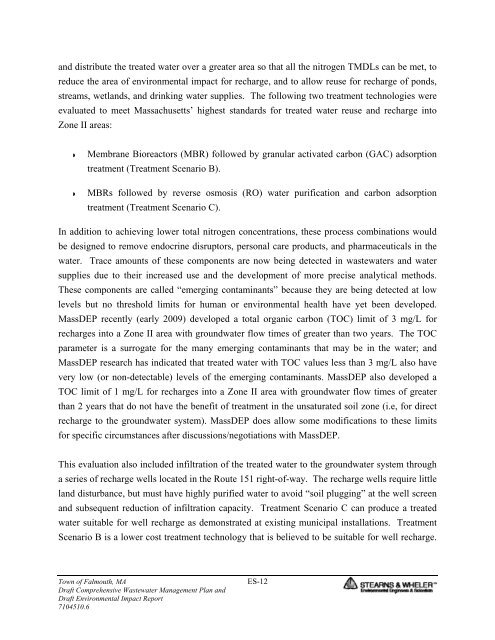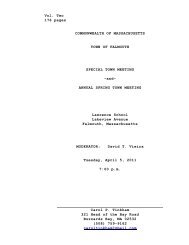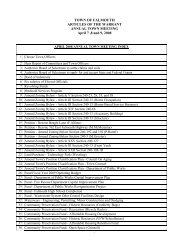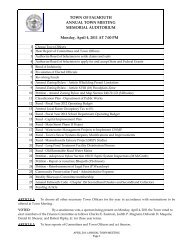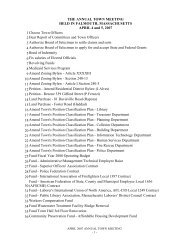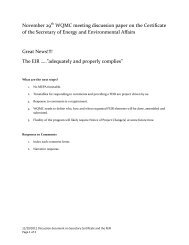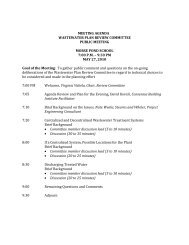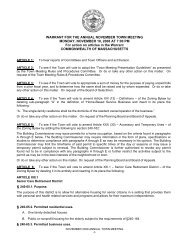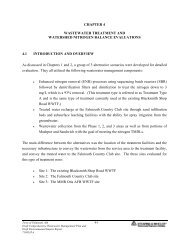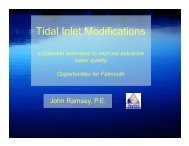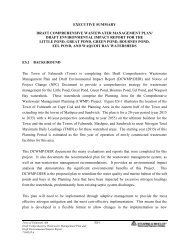EXECUTIVE SUMMARY (Without Figures) rev - Town of Falmouth
EXECUTIVE SUMMARY (Without Figures) rev - Town of Falmouth
EXECUTIVE SUMMARY (Without Figures) rev - Town of Falmouth
Create successful ePaper yourself
Turn your PDF publications into a flip-book with our unique Google optimized e-Paper software.
and distribute the treated water over a greater area so that all the nitrogen TMDLs can be met, to<br />
reduce the area <strong>of</strong> environmental impact for recharge, and to allow reuse for recharge <strong>of</strong> ponds,<br />
streams, wetlands, and drinking water supplies. The following two treatment technologies were<br />
evaluated to meet Massachusetts’ highest standards for treated water reuse and recharge into<br />
Zone II areas:<br />
Membrane Bioreactors (MBR) followed by granular activated carbon (GAC) adsorption<br />
treatment (Treatment Scenario B).<br />
MBRs followed by <strong>rev</strong>erse osmosis (RO) water purification and carbon adsorption<br />
treatment (Treatment Scenario C).<br />
In addition to achieving lower total nitrogen concentrations, these process combinations would<br />
be designed to remove endocrine disruptors, personal care products, and pharmaceuticals in the<br />
water. Trace amounts <strong>of</strong> these components are now being detected in wastewaters and water<br />
supplies due to their increased use and the development <strong>of</strong> more precise analytical methods.<br />
These components are called “emerging contaminants” because they are being detected at low<br />
levels but no threshold limits for human or environmental health have yet been developed.<br />
MassDEP recently (early 2009) developed a total organic carbon (TOC) limit <strong>of</strong> 3 mg/L for<br />
recharges into a Zone II area with groundwater flow times <strong>of</strong> greater than two years. The TOC<br />
parameter is a surrogate for the many emerging contaminants that may be in the water; and<br />
MassDEP research has indicated that treated water with TOC values less than 3 mg/L also have<br />
very low (or non-detectable) levels <strong>of</strong> the emerging contaminants. MassDEP also developed a<br />
TOC limit <strong>of</strong> 1 mg/L for recharges into a Zone II area with groundwater flow times <strong>of</strong> greater<br />
than 2 years that do not have the benefit <strong>of</strong> treatment in the unsaturated soil zone (i.e, for direct<br />
recharge to the groundwater system). MassDEP does allow some modifications to these limits<br />
for specific circumstances after discussions/negotiations with MassDEP.<br />
This evaluation also included infiltration <strong>of</strong> the treated water to the groundwater system through<br />
a series <strong>of</strong> recharge wells located in the Route 151 right-<strong>of</strong>-way. The recharge wells require little<br />
land disturbance, but must have highly purified water to avoid “soil plugging” at the well screen<br />
and subsequent reduction <strong>of</strong> infiltration capacity. Treatment Scenario C can produce a treated<br />
water suitable for well recharge as demonstrated at existing municipal installations. Treatment<br />
Scenario B is a lower cost treatment technology that is believed to be suitable for well recharge.<br />
<strong>Town</strong> <strong>of</strong> <strong>Falmouth</strong>, MA ES-12<br />
Draft Comprehensive Wastewater Management Plan and<br />
Draft Environmental Impact Report<br />
7104510.6


